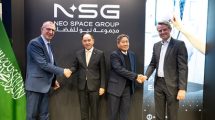 The satellite industry forms 75% of the space economy, with satellite services and ground equipment the highest-revenue segments. In the last decade, satellite industry revenues were around $230bn; 2020-2030 is expected to exceed $300bn with a growth rate of 23%, not counting low-Earth orbit (LEO) commercial services. Satellite services revenues have remained the largest industry segment, with revenues reaching $125bn, though these fell to $116bn in 2020.
The satellite industry forms 75% of the space economy, with satellite services and ground equipment the highest-revenue segments. In the last decade, satellite industry revenues were around $230bn; 2020-2030 is expected to exceed $300bn with a growth rate of 23%, not counting low-Earth orbit (LEO) commercial services. Satellite services revenues have remained the largest industry segment, with revenues reaching $125bn, though these fell to $116bn in 2020.
The MENA region has a long history in investment in geostationary Earth orbit (GEO) services; demand makes it one of the largest markets after North America, focused on TV broadcasting, mobility, inflight connectivity (IFC), LTE and hybrid networks, government and military. The new non-geostationary satellite orbit (NGSO) space will revive the globe with hundreds and thousands of satellites for broadband connectivity from LEO and medium-Earth orbit (MEO). For global coverage, the equation is three GEO satellites equals six MEO satellites, equals hundreds of LEO satellites. NGSO (LEO-MEO) provides higher bandwidth than GEO.
The NGSO upstream market is expanding rapidly, with high capital investment to accelerate the demand for downstream services with lower operational costs. The NGSO sector will extend opportunities to different vertical markets in the MENA region with high-speed connectivity such as maritime, oil & gas, IFC, 5G, connected devices, video streaming, government and military, as well as direct consumers and households in rural areas.
Dissecting the landscape and spotting demand
The go-to-market strategy: Countries such as Saudi Arabia and the UAE are investing heavily in industry 4.0 national space programmes, energy and smart cities, which will create demand and opportunities in the NGSO sector. Tawazunin Abu Dhabi is partnering with Airbus and the National Space Science and Technology Centre (NSSTC) to initiate the country’s first small-to-medium satellite component manufacturing unit and conduct AIT. With this, the UAE will be the first Middle Eastern country to unleash the region’s opportunities in the upstream NGSO market.
Saudi Arabia’s Vision 2030 initiative will trigger demand or acceleration across satellite verticals. In the future, the Saudi Space Commission (SSC) will help to further grow the satcom upstream market by shaping new policies and regulations locally. This will create more opportunities in the NGSO upstream market, with support from local semi-government organisations and operators. Simultaneously, with the emergence of the Egyptian Space Agency and Turkish national programmes/initiatives, both Nilesat and Turksat are likely to show interest in the NGSO commercial market.
The MENA region is investing strongly in terrestrial, OTT and pay-TV. According to the NGSO forecast, there will be dedicated high availability of Tbps capacity, which will increase the terrestrial bandwidth via NGSO satellites to further support OTT developments.
Orbofleet forecasts that by 2022, in the NGSO broadband space, Ku-band capacity will reach up to 4Tbps to provide capacity services targeting businesses, mobility and government markets, while other NGSO operators focused on Ka-band will surpass 40Tbps by 2026. From 2027, Q/V-band will gain momentum commercially. This dynamic progress in the use of different high-frequency bands will mean low operational expenditure (OPEX), leading to the opening of business gateways for new downstream customers while also fulfilling their requirements.
Global opportunities with a key focus on MENA
In the short term, OneWeb, SpaceX’s Starlink and SES mPower’s upcoming satellites will create opportunities that increase NGSO demand, especially in rural areas, industrial, mobility and GSM backhaul, and among direct consumers with low-cost operations.
Satellite-based IoT is a crucial solution for the MENA region. IoT provides more flexibility and reduces the operational cost of connecting devices and machines in industrial verticals such as agriculture, oil & gas, SCADA, emergencies and transportation connectivity. LEO satellite constellations will also supplement terrestrial 5G infrastructure in the Middle East.
NGSO’s pace of innovation has encouraged existing LEO operators to develop, build and provide a LEO network based on VDES technology, a second-generation automatic identification system (AIS) supporting Maritime and Sea, a crucial application in the MEA region’s maritime market. NGSO operators have created initiatives to enter MENA and have conducted business opportunity surveys in the Middle East to expand their business units.
Africa remains an opportunity for foreign NGSO satellite operators, as local telecom operators already have a significant presence in Sub-Saharan Africa.
In the last few years, the Gulf region and North Africa have expanded the local market by founding national space agencies such as the UAE Space Agency, the Saudi Space Commission, the Egyptian Space Agency and the National Space Science Agency in Bahrain. These initiatives will allow small-to-medium satellite businesses to serve their local needs from LEO, such as remote sensing, but will dedicate space and opportunity in the satcom and telecom applications for both upstream and downstream markets
Conclusion
With the impact of Covid-19, the world has seen huge demand for applications such as Zoom and Microsoft Teams. Their intensive use during the lockdown put huge pressure on terrestrial broadband capacity. Support for this via GEO satellites will be limited in terms of speed and high latency. Pandemics and other such emergencies will accelerate demand via NGSO to feed these hybrid networks with higher capacity and speed.
The MENA region will boost not only the downstream but also the upstream local market, through continuous investment in the space and satellite industry. Regional satellite operators such as Arabsat, E’shailsat, Nilesat and Yahsat will no doubt continue to invest in the GEO business, but some of them are also involved in partnerships that will eventually unlock future NGSO opportunities.
 Rami Ibrahim is CEO of Orbofleet Space Company.
Rami Ibrahim is CEO of Orbofleet Space Company.














Add Comment